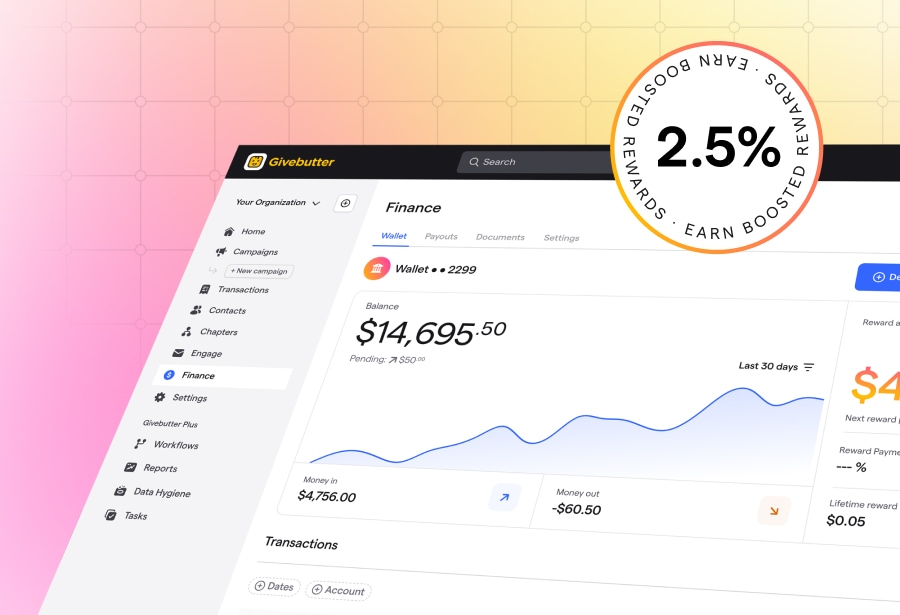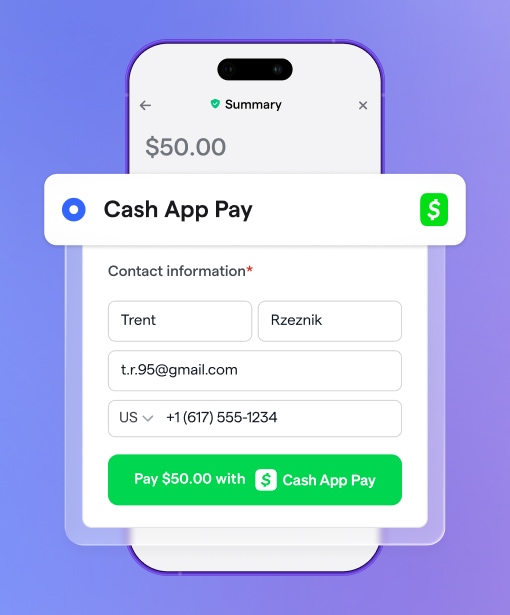Table of contents
Table of contents
The highest-performing nonprofits aren’t just lucky. They set goals that are mission-aligned, data-driven, and broken down into small, achievable milestones. It’s a repeatable strategy any nonprofit can use.
This guide shows you, step by step, how to set a fundraising goal that builds momentum, rallies supporters, and positions your organization for its strongest year yet.
Key takeaways
- Set a SMART goal 🤓 Set your nonprofit up for success with a fundraising goal that’s specific, measurable, achievable, relevant, and time-bound.
- Share your goal 📣 Don’t keep your goal to yourself—share it with your team, board members, and supporters so everyone can play a part in making it happen.
- Break your goal into smaller milestones 🧩 Breaking your goal down into smaller targets helps you stay on track and build momentum.
- Measure your progress 📈 Set time aside regularly to review your progress and adapt your strategy as needed. Sharing your progress is also a great way to motivate supporters.
- Find the goal that fits your mission 🫶 From event fundraising to major gifts, choose the fundraising goal type that best supports your organization’s vision.
- Use the right tools 🔧 Givebutter has everything you need to help make your nonprofit’s goals a reality—including event management software, communications tools, and more.
How to set a fundraising goal in 5 simple steps
Goal setting may seem simple—but setting a successful, mission-aligned goal usually requires intentional time and effort. Fortunately, the steps below make setting achievable goals easier than ever.
Step 1: Start with your purpose 💛
Consider your nonprofit's broader objectives, including its programs, beneficiaries, and guiding principles. With the big picture in mind, it’s easier to set meaningful goals.
💡 Pro tip: Don’t get into the details just yet. Instead, think about the values that drive your nonprofit. Remember, you can always refine your strategy as you go.
Step 2: Calculate your fundraising goal 🧮
Determine your fundraising goals based on previous data from your nonprofit and industry benchmarks. (We’ve also included more details on how to calculate each of your goals in the section below.)
To set goals that empower your organization, use the SMART goal framework. Answer the following questions:
- Is your goal specific?
- Can you track and measure progress made toward your goal over time?
- Is your goal realistically achievable?
- Is your goal relevant to your organization’s big-picture plans?
- Do you have a time-bound deadline?
You’ll know you’re on the right lines if you can answer “Yes” to all the questions above.
⚡ Example: Instead of “Get more donations,” your SMART goal will be something like “Acquire 10 new donors with an average gift amount of $30 by the end of the year.”
💡 Pro tip: Set three revenue goals—minimum, target, and aspirational—to stay flexible as you begin fundraising.
Step 3: Break it into smaller milestones 🎯
Turn your large goal into several smaller goals. This helps you build momentum, stay on the right track, and maintain high motivation as you move toward your goal.
⚡ Example: If you’re looking to secure corporate sponsors, start with a total fundraising goal. Then, break this large goal down into the three smaller goals below:
- Number of corporations to reach out to
- Number of corporate partnerships you’d like to secure
- Average fundraising amount to secure from each sponsor
Breaking your goal into measurable targets streamlines the process, making it easier to focus on your fundraising objectives.
Step 4: Track and share your progress 📊
Set a specific period of time to review your progress and determine if your current strategy is working or if you need to make adjustments. Share your progress with your internal team, board members, and supporters.
💡 Pro tip: Use Givebutter’s donation management and reporting tools to easily monitor performance and refine your strategy as needed.
.webp)
Track your goals with a free fundraising thermometer
Step 5: Motivate supporters to help you hit your goal 🔥
Enlist your support base and get them excited about helping your nonprofit reach its goals. Be specific—tell them why you chose this goal, how it will help your beneficiaries, and how they can get involved. Share progress updates to boost motivation.
⚡ Example: A cat sanctuary sets a goal of securing 10 recurring donors by the end of the year. They launch a social media fundraising campaign, sharing that every recurring donor helps care for two kittens. They even offer an extra incentive with a special “Kitten meet and greet” for the first five sign-ups.
10 SMART fundraising goals to boost donations now & later
No two nonprofits are the same—which means your fundraising goals shouldn’t be, either. Fortunately, there are 10 different types of goals that any nonprofit can set. We’ve outlined these below, including the approach to take and the simple steps to achieve them.
1. Total fundraising goal 💸
Whether you’re focusing on how much money to raise per year, per fundraising campaign, or per project, it’s essential to set your total fundraising goal amount and track your progress over time.
🤔 Why it matters: Financial success is different for everyone. A total revenue goal helps you define what financial success looks like for your organization. It also makes it easier to move strategically toward long-term financial sustainability.
🎯 How to set a realistic goal: Review your organization's data and industry norms to create a more informed and attainable target.
💡 Pro tips to hit your goal:
- Diversify your revenue streams: Apply for grants, launch peer-to-peer fundraising campaigns, host events, and seek major gifts or corporate sponsorships.
- Become a storyteller: Supporters want to feel part of your mission beyond just making donations. Engage them with compelling narratives, beneficiary spotlights, and impact reports.
2. Donor retention goal 🫶
Donor retention is a key component of the donor life cycle. After a supporter makes their first donation, shift your efforts from acquisition to long-term engagement with your mission.
🤔 Why it matters: Did you know the average lifetime giving value of a recurring donor is an impressive $7.6K? Recurring donors contribute significantly more over their lifetime than one-time donors. Plus, retaining supporters requires fewer resources than acquiring new ones.
🎯 How to set a realistic goal: Start by analyzing your donor churn rate—how many of last year’s donors gave again? Use this data to set a realistic retention goal.
Here’s how to calculate your donor retention rate:
💡 Pro tips to hit your goal:
- Show appreciation: Set up automated thank-you messages with Givebutter’s workflows to ensure every donor feels valued.
- Encourage recurring giving: Launch a recurring donor program with clear incentives.
- Make it personal: Use email and SMS tools to send personalized updates, impact stories, and donation appeals to past donors.
3. Donor acquisition goal ☺️
A donor acquisition goal focuses on attracting new supporters, whether through a one-time gift or a recurring donation.
🤔 Why it matters: Donor acquisition expands your support base and fuels growth. It creates more opportunities for recurring giving and means you’re not relying on one small group of donors.
🎯 How to set a realistic goal: Acquiring new donors can be costly, so it’s important to create a realistic goal based on your donor acquisition rate. Use this formula to calculate your donor acquisition rate:
⚡ Example: If you had 30 new donors this year and your total number of donors is 150, your acquisition rate is 25%. Set a donor acquisition goal of 30% in the coming year.
💡 Pro tips to hit your goal:
- Leverage social media: Use social media to run targeted awareness campaigns. Remember, folks who are new to your organization need a broad overview of your work and mission.
- Engage donors: Equip your supporters with resources they need to spread the word about your mission.
- Simplify giving: Streamline your giving page so it’s simple and easy to use. Accept all forms of payment, including Venmo, checks, and credit cards.
4. Recurring giving goal 🪙
Do you have supporters who have donated to your nonprofit once or twice? If so, these are great candidates for upgrading to recurring donors.
🤔 Why it matters: Recurring donors bring predictable revenue streams and lead to greater financial stability. Plus, recurring donors tend to be more engaged—50% go on to make additional gifts, according to Giving USA.
🎯 How to set a realistic goal: Set your target based on your previous year’s conversion rates. Use a recurring donation platform to ensure your fundraising forms are set up to receive repeat donations.
We’ve included a great example of a recurring donation form below:

💡 Pro tips to hit your goal:
- Offer exclusive benefits: Show your recurring donors special treatment with special events, donor clubs, and exclusive annual impact reports.
- Spread the word: Promote the value of recurring giving during major fundraising events and campaigns.
- Be patient: The average recurring donor gives for eight years, so even a small increase in recurring donors adds up. Your goal doesn’t have to be lofty to make a real difference.
5. Major gifts goal 💰
Major gifts are typically in the hundreds or thousands—$1K, $5K, $10K, or more. Set your goal based on the number of major donors you aim to secure and the total amount you wish to raise.
🤔 Why it matters: According to the 80/20 rule for fundraising, 80% of fundraising revenue typically comes from just 20% of donors, making major gifts an essential fundraising strategy.
🎯 How to set a realistic goal: Use previous giving data to determine what qualifies as a major gift for your organization. With wealth screening tools, like DonorSearch, you can identify donors who have already demonstrated commitment to your mission and have the capacity to give.
💡 Pro tips to hit your goal:
- Practice donor stewardship: Develop individualized stewardship plans to build relationships with major gift prospects.
- Tap into your network: Let your board members and top supporters know you're seeking major gifts and ask for introductions to potential donors.
- Celebrate your donors: Once you secure a major gift, recognize donors with meaningful gestures such as plaques, artwork, or naming rights.
6. Peer-to-peer fundraising goal 🧑🏽🤝🧑🏻
A peer-to-peer fundraising goal is a target set by a nonprofit to encourage supporters to fundraise on its behalf.
🤔 Why it matters: Peer-to-peer fundraising is one of the most effective avenues to donor acquisition. Research shows that, on average, peer-to-peer campaign donors contribute more than twice the amount of direct donors, though exact success rates vary by campaign type.
🎯 How to set a realistic goal: A peer-to-peer fundraising goal typically includes:
- Number of fundraisers the nonprofit aims to recruit
- Total amount of donations expected from peer-to-peer campaigns
- Average donation per fundraiser to gauge individual impact
💡 Pro tips to hit your goal:
- Offer resources and templates: Make fundraising on your behalf as easy as possible with messaging templates and information packs.
- Celebrate your supporters: Recognize top fundraisers by featuring them on your website and social media.
- Give public proof: Set up your fundraising page to track real-time progress and keep your peer-to-peer fundraisers motivated.
- Use the right tools: With Givebutter’s peer-to-peer fundraising tools, you can create fully customizable, branded fundraising pages.
7. Event fundraising goal 🎈
Concentrate your efforts on one day with a fundraising event goal. Whether in-person, virtual, or hybrid, the key is to foster connections and raise money for your cause.
🤔 Why it matters: Events provide an opportunity for memorable face-to-face engagement with supporters and, when done right, can bring a significant influx of funds for your organization.
🎯 How to set a realistic goal: Base your event fundraising goal on ticket sales, sponsorships, and donations from previous events. Keep in mind that different event types yield different results—don’t compare a charity run to a gala or an auction to a concert.
💡 Pro tips to hit your goal:
- Offer sponsorship: Sponsors can offset overhead costs while increasing revenue and visibility.
- Encourage engagement: Use gamification, live display leaderboards, and real-time fundraising activity tracking to boost contributions.
- Make it accessible: Livestream your event to engage remote supporters and increase participation.
8. Corporate sponsorship goal 🧑💼
Corporate sponsors can offer both monetary and in-kind donations, so your goal may focus on securing specific goods or services rather than a fundraising figure.
🤔 Why it matters: Corporate sponsorships and business partnerships can drive a steady, predictable cash flow and grow your giving community.
🎯 How to set a realistic goal: Use past partnerships or industry benchmarks to set your goal. Establish specific funding tiers with clear, achievable amounts that appeal to businesses of different sizes.
💡 Pro tips to hit your goal:
- Go beyond exposure: Offer more than just logo placement—run co-branded campaigns, engage employees, or create volunteer opportunities.
- Track impact: Give corporate partners public recognition in newsletters, social media, and donor reports, and provide detailed reports showcasing the outcomes of their contributions.
9. Grant funding goal ✍️
A grant funding goal aims to secure significant financial support from foundations and grant-making organizations.
🤔 Why it matters: Grants reduce reliance on donor contributions, helping to prevent donor burnout. They’re also especially useful for kickstarting a new program.
🎯 How to set a realistic goal: Set application targets based on your capacity to submit and manage proposals. Next, assess the projected costs of your programs or initiatives to determine your funding needs.
💡 Pro tips to hit your goal:
- Craft your proposal: Successful proposals are compelling, concise, evidence-based, and outcome-focused.
- Cultivate relationships: Build strong relationships with grant officers and funders to gain valuable insight and increase your chances of success.
- Base goals on capacity: Keep your goals attainable and flexible—writing grant proposals can be time-intensive, especially if this is your first time.
10. Fundraising cost efficiency goal 💡
A fundraising cost efficiency goal helps you maximize revenue while minimizing overall expenses, allowing you to make the most of your available resources.
🤔 Why it matters: When overhead costs are low, more funds directly support your mission.
🎯 How to set a realistic goal: Start by reviewing past fundraising expenses. Focus on lowering overhead and replicating successful, low-cost campaigns. Then, compare fundraising expenses to the money raised, and aim to improve cost efficiency year over year.
💡 Pro tips to hit your goal:
- Optimize digital campaigns: Enhance your digital presence to make it easier for new supporters to find you with minimal cost.
- Focus your efforts: Prioritize high-ROI fundraising methods like recurring giving and peer-to-peer fundraising.
- Eliminate platform costs: Consider free platforms to reduce or eliminate fees altogether.
Surpass your fundraising goals with Givebutter
Follow the steps above to create thoughtful, mission-aligned goals, and you’ll be amazed at what your nonprofit can achieve. Once you’ve met your goal, reconvene, evaluate your priorities, and set a new goal—the sky’s the limit.
Givebutter’s real-time reporting and built-in donation management—like goal tracking thermometers, recurring donations, match challenges, and more—make it easier than ever for nonprofits to set, track, and exceed their fundraising goals.
⭐ Sign up with Givebutter and start reaching your fundraising goals today.
FAQs about nonprofit organization goals
What are good donation goals?
Financial success looks different for every nonprofit. This means good donation goals also vary, depending on your current fundraising operations and strategy.
Base your donation goal on your previous donation history and industry benchmarks, and try other types of nonprofit fundraising goals, such as donor retention, recurring giving, or cost-efficiency goals.
What KPIs should you track for fundraising goals?
Track key KPIs like donor retention rate, donor conversion rate, donor growth rate, average gift size, fundraising ROI, and year-over-year revenue growth.
For even deeper insights, pair fundraising data with supporter feedback. Regularly send donors a feedback form to learn more about what’s working well and where you can adapt.
How can auctions boost your fundraising goals?
Auctions are popular and often lucrative fundraising events. To raise even more, ask local businesses to donate auction items or host an online auction so supporters can participate from anywhere.
How often should you update your fundraising goals?
Review your fundraising goals regularly so you can adapt your strategy if necessary. Check in on long-term goals at least quarterly. For an active, time-limited campaign, monitor your progress weekly—or even daily.
.svg)






%20(1).png)



.svg)
















